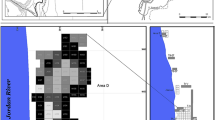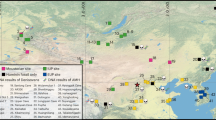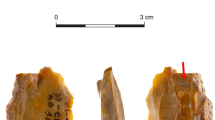Abstract
Stone tools are durable reminders of the activities, skills and customs of early humans, and have distinctive morphologies that reflect the development of technological skills during the Pleistocene epoch. In Africa, large cutting tools (hand-axes and bifacial chopping tools) became part of Palaeolithic technology during the Early Pleistocene (∼1.5 Myr ago)1,2,3. However, in Europe this change had not been documented until the Middle Pleistocene (<0.5 Myr ago)4,5. Here we report dates for two western Mediterranean hand-axe sites that are nearly twice the age of the supposed earliest Acheulian in western Europe. Palaeomagnetic analysis of these two sites in southeastern Spain found reverse polarity magnetozones, showing that hand-axes were already in Europe as early as 0.9 Myr ago. This expanded antiquity for European hand-axe culture supports a wide geographic distribution of Palaeolithic bifacial technology outside of Africa during the Early Pleistocene.
This is a preview of subscription content, access via your institution
Access options
Subscribe to this journal
Receive 51 print issues and online access
$199.00 per year
only $3.90 per issue
Buy this article
- Purchase on Springer Link
- Instant access to full article PDF
Prices may be subject to local taxes which are calculated during checkout



Similar content being viewed by others
References
Asfaw, B. et al. The earliest Acheulean from Konso-Gardula. Nature 360, 732–734 (1992)
Isaacs, G., Ll & Curtis, G. H. Age of early Acheulean industries from the Peninj Group, Tanzania. Nature 249, 624–627 (1974)
Chazan, M. et al. Radiometric dating of the Earlier Stone Age sequence in Excavation I at Wonderwerk Cave, South Africa: preliminary results. J. Hum. Evol. 55, 1–11 (2008)
Monnier, G. F. The Lower/Middle Palaeolithic periodization in Western Europe: an evaluation. Curr. Anthropol. 47, 709–744 (2006)
Santonja, M. & Villa, P. in Axe Age. Acheulian Toolmaking from Quarry to Discard (eds Goren-Inbar, N. & Dibble, H. L.) 429–478 (Equinox, 2006)
Goren-Inbar, N. et al. Pleistocene milestones on the Out-of-Africa Corridor at Gesher Benot Ya’aqov, Israel. Science 289, 944–947 (2000)
Yamei, H. et al. Mid-Pleistocene Acheulean-like stone technology of the Bose Basin, south China. Science 287, 1622–1626 (2000)
Bar-Yosef, O. & Goren-Inbar, N. The lithic assemblages of ‘Ubeidiya: a Lower Palaeolithic site in the Jordan Valley. Monogr. Inst. Archaeol. Qedem 34 (Hebrew University of Jerusalem, 1993)
Bermúdez de Castro, J. M. et al. The Atapuerca sites and their contribution to the knowledge of human evolution in Europe. Evol. Anthropol. 13, 25–41 (2004)
Aguirre, E. Homo hispánico (Editorial Espasa Calpe, 2008)
Botella, M. C., Vera, J. A. & de Porta, J. El yacimiento achelense de la “Solana del Zamborino”, Fonelas (Granada). Primera campaña de excavaciones. Cuad. Prehist. Univ. Granada 1, 1–45 (1975)
Walker, M. J. in A Very Remote Period Indeed. Papers on the Palaeolithic presented to Derek Roe (eds Milliken, S. & Cook, J.) 153–159 (Oxbow Books, 2001)
Ruiz Bustos, A. in The Hominids and their Environment in the Middle and Lower Pleistocene of Eurasia (eds Gibert, J., Sánchez, F., Gibert, L. & Ribot, F.) 153–174 (Museo de Prehistoria y Paleontología de Orce, 1995)
Walker, M. J. et al. Cueva Negra del Estrecho del Río Quípar (Murcia, southeast Spain): An Acheulian and Levalloiso-Mousteroid assemblage of Palaeolithic artifacts excavated in a Middle Pleistocene faunal context with hominin skeletal remains. Eurasian Prehistory 4, 3–43 (2006)
Scott, G. R., Gibert, L. & Gibert, J. Magnetostratigraphy of the Orce region (Baza Basin), SE Spain: new chronologies for Early Pleistocene faunas and hominin occupation sites. Quat. Sci. Rev. 26, 415–435 (2007)
Gibert, L., Scott, G., Martin, R. & Gibert, J. The Early to Middle Pleistocene boundary in the Baza Basin (Spain). Quat. Sci. Rev. 26, 2067–2089 (2007)
Gibert, L., Ortí, F. & Rosell, L. Plio-Pleistocene lacustrine evaporites of the Baza Basin (Betic Chain, SE Spain). Sed. Geol. 200, 89–116 (2007)
Gradstein, F. M. et al. A Geological Time Scale 2004 (Columbia Univ. Press, 2004)
Gibert, L., Scott, G. & Ferràndez-Cañadell, C. Evaluation of the Olduvai subchron in the Orce ravine (SE Spain). Implications for Plio-Pleistocene mammal biostratigraphy and the age of Orce archeological sites. Quat. Sci. Rev. 25, 507–525 (2006)
Parfitt, S. A. et al. The earliest record of human activity in northern Europe. Nature 438, 1008–1012 (2005)
Coltorti, M. et al. New 40Ar/39Ar, stratigraphic and palaeoclimatic data on the Isernia La Pineta Lower Palaeolithic site, Molise, Italy. Quat. Int. 131, 11–22 (2005)
Gibert, J., Gibert, L., Ferràndez-Canyadell, C., Iglesias, A. & González, F. in The Human Evolution Source Book (eds Ciochon, R. L. & Fleagle, J. G.) 327–335 (Pearson Prentice Hall, 2007)
Borja, C., García-Pacheco, M., Olivares, E. G., Scheuenstuhl, G. & Lowenstein, J. M. Immunospecificity of albumin detected in 1.6 million-year-old fossils from Venta Micena in Orce, Granada, Spain. Am. J. Phys. Anthropol. 103, 433–441 (1997)
Gibert, J. El Hombre de Orce: los Homínidos que Llegaron del sur (Editorial Almuzara, 2004)
Dennell, R. Dispersal and colonisation, long and short chronologies: how continuous is the Early Pleistocene record for hominids outside East Africa? J. Hum. Evol. 45, 421–440 (2003)
Anton, S. C. & Swisher, C. C. Early dispersals of Homo from Africa. Annu. Rev. Anthropol. 33, 271–296 (2004)
Coe, R. S., Singer, B. S., Pringle, M. S. & Zhao, X. Matuyama–Brunhes reversal and Kamikatsura event on Maui: Palaeomagnetic directions, 40Ar/39Ar ages and implications. Earth Planet. Sci. Lett. 222, 667–684 (2004)
Ciaranfi, N., van Kolfschoten, T. & Coltorti, M. The Plio-Pleistocene boundary and the Lower/Middle Pleistocene transition: type areas and sections—an introduction. Quat. Int 131, 1–3 (2005)
Gibert, J. et al. Cueva Victoria: Geología, Paleontología, restos humanos y edades. Mem. Arqueología Región Murcia 14, 37–62 (2006)
Acknowledgements
Partial funding and support was from the Fullbright Scholar Program (L.G.), Fundación Española para la Ciencia y la Tecnología (L.G.), project 05584/ARQ/07 of the Fundación Séneca (M. Walker), project CGL2005-05337BTE of the Dirección General de Investigación (L. Rosell), and the Earthwatch Institute (L.G.). For discussions, laboratory, and field assistance we thank J. Gibert, M. Walker, R. Martin, C. Ferràndez, J. Butterworth, L. Hinton, M. Lería, A. López-Jiménez, M. López-Martínez, S. Matson, J. Ortega, F. Ribot, A. Ruiz-Bustos and L. Smeenk. We also thank the Museo Arqueológico de Vélez Rubio (Almería) for access to their collection from Solana del Zamborino, R. Goméz Torres for access to the Solana del Zamborino site, and M. Walker for access to fossils/artefacts and sampling at Estrecho del Quípar. We acknowledge the late J. Gibert Clols for encouraging the development of this research and providing the large mammal fauna identifications.
Author Contributions The authors of this paper contributed equally. G.R.S. directed the palaeomagnetic measurements and assisted in field sampling, and L.G. directed the palaeomagnetic field sampling and assisted in laboratory measurements.
Author information
Authors and Affiliations
Corresponding author
Supplementary information
Supplementary Information
This file contains Supplementary Methods, a Supplementary Discussion, Supplementary References, Supplementary Figures 1-4 with Legends and Supplementary Table 1. (PDF 763 kb)
Rights and permissions
About this article
Cite this article
Scott, G., Gibert, L. The oldest hand-axes in Europe. Nature 461, 82–85 (2009). https://doi.org/10.1038/nature08214
Received:
Accepted:
Issue Date:
DOI: https://doi.org/10.1038/nature08214
This article is cited by
-
Hyaenas and early humans in the latest Early Pleistocene of South-Western Europe
Scientific Reports (2021)
-
La Noira Site (Centre, France) and the Technological Behaviours and Skills of the Earliest Acheulean in Western Europe Between 700 and 600 ka
Journal of Paleolithic Archaeology (2020)
-
Cueva Negra del Estrecho del Río Quípar: a Dated Late Early Pleistocene Palaeolithic Site in Southeastern Spain
Journal of Paleolithic Archaeology (2020)
-
The earliest evidence of Acheulian occupation in Northwest Europe and the rediscovery of the Moulin Quignon site, Somme valley, France
Scientific Reports (2019)
-
First evidence of an extensive Acheulean large cutting tool accumulation in Europe from Porto Maior (Galicia, Spain)
Scientific Reports (2018)
Comments
By submitting a comment you agree to abide by our Terms and Community Guidelines. If you find something abusive or that does not comply with our terms or guidelines please flag it as inappropriate.



